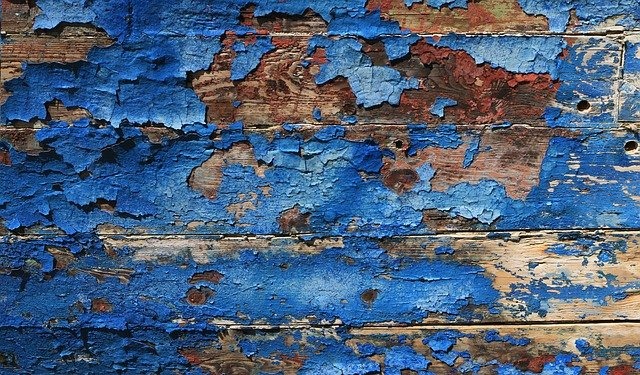
Before you know it, cracking or bubbling paint can appear on your interior or exterior surfaces walls. They’re unsightly and unappealing, detracting from the rest of the room’s decor and even causing structural damage in some cases.
The good news is that it’s not difficult to fix cracked paint, and it doesn’t have to be expensive. With the right tools and know-how, this is a project you can complete by yourself. Below we’ll explore some of the causes of cracking paint and how to fix them.
Can You Paint over Peeling or Cracked Paint?
While you can simply paint over the top of peeling or cracked paint, this only takes care of the symptom, not the problem. Once painted over, you’ll eventually see cracks continue to form from your underlying layer, ruining your newly painted surface and wasting time if you opt to start over. Because of this reason, it’s best to fix cracked paint from the surface before splashing on a new layer of paint.
What causes Cracked Paint?
You’ll generally see paint cracking when your coat doesn’t properly adhere to its surface, especially if it’s an older or highly textured surface. Cracked paint, meanwhile, occurs when your dried paint layers expand and contract at different rates, causing them to split or crack.
Despite their differences, paint peeling and cracked paint can also be caused by a number of reasons, which include:
Poor surface preparation: If you haven’t adequately sanded, cleaned and primed the surface, your paint won’t adhere as effectively. Here are some guides you might find useful when painting on various surfaces:
Here are more tips on How To Prepare Walls For Painting.
Excess moisture: Environments prone to excess moisture or high humidity can dampen your walls and cause paint to peel.
Low-quality paint or diluted paint: If you’re using poor quality paint, your finished layers will not be as durable as those painted with high-quality paint. Paint that has been diluted with too much thinner will also lack the proper pigment to hold together, causing paint layers to crack.
Are Cracks in Paint Normal?
Cracking paint is mainly prevalent in older homes, where the walls haven’t been repainted in years. Newly painted surfaces typically don’t begin to show cracks until one year after application, and thinner layers of paint are likely to split more quickly. Oil painting takes longer to crack, but the oxidation process eventually cracks across the surface.
Safety Precautions to Take Before Fixing Paint Cracking
Before going through the necessary steps to fix cracking or chipping paint, it’s essential to test your walls for lead-based paint. Scraping lead paint off releases lead dust, which can lead to neurological damage and other serious health problems. It’s especially harmful to children and pregnant women. If lead paint is standard in your home, it’s best to contact a professional lead-paint abatement service for it’s removal.
Looking to repair or remove your popcorn ceiling? Check this out!
How to Fix Cracked Paint
Once your wall’s coat layers have begun to separate and bubble, they will eventually crack and chip. It’s at this stage that you’ll need to remove loose paint by filling in cracks or holes with a joint compound. Another quick solution is to brush away peeling paint, but it’s not ideal if the damage extends several layers deep.
Tools & Supplies
- Six-in-one tool
- Putty knife
- Wire brush
- Primer
- Sandpaper
- Vacuum cleaner
- Joint compound
Step One – Scrape Away Hanging Paint
First and foremost, you’ll need to scrape away the paint peeling from your ceilings or walls. With your 6-1 tool in hand, simply run the paint scraper against the paint layers until you’ve cleared away any loose paint. However, be sure not to gouge your wood, which can damage the underlying surface material.
Step Two – Brush Away Paint Residue
After you’ve cleared away any loose or hanging paint flakes, use your wire brush to smoothen out loose edges and brush away any stuck-on paint debris or residue. Use a damp cloth to wipe off dust.
Step Three – Fill in Cracks & Holes with Joint Compound
With cracks smoothened out, it’s time to fill in any remaining holes or cracks. Spread a thin layer of the joint compound onto your putty knife and apply it to the damaged area – a few coats should suffice. Make sure to apply your filler beyond its perimeter and dry with a heat gun if you’re under specific time restraints.
For plastered walls, an excellent alternative to fill in holes and cracks is Plaster of Paris. Just be sure to mix your plaster of Paris with water until it forms a thick paste.
Step Four – Wait to Dry and Sand Down Filler Edges
Before sanding, wait until your joint compound has dried. Drying times will be in accordance with your filler’s manufacturer instructions, but let it dry for at least 45 minutes to 1 hour.
Once dried, sand the filler with your sandpaper until it is flush with the surface of your wall. You may choose to use an oscillating sander to speed up the process, but be sure not to overdo it and remove too much paint.
Step Five – Ensure a Smooth Finish before Your Paint Job
Before applying primer, you’ll need to ensure that your wall is smooth from the paint removal process. If you still have wall dips, repeat the steps above until your walls are smooth. For humps, continue to sand the area until it’s flat and even.
When you can run your bare hand across the surface of the wall and feel no bumps or ridges, you’re ready to prime your wall.
Step Six – Prime & Apply Paint
Vacuum clean or wipe your wall down and apply your primer. Painting two coats seals your repair job and gives an even finish that’s uniform in colour.
Preventing Paint Cracking on Walls

Now that you know how to fix peeling and cracking paint, there are some preventative measures you can take to ensure it doesn’t happen as frequently.
Invest in an Air Conditioner – Preventing this can be as easy as investing in an air conditioner. As humidity levels rise, so does the likelihood that your paint will crack. By keeping your home cooler when the humidity increases, you can help keep your paint in good condition.
Paint Sealant: Water weakens your paints ability to stick to your walls. One way to circumvent this is by applying a paint sealant to your paint. This blocks water from penetrating your paint’s surface, thus preventing it from peeling.
Prepare Your Surface: As mentioned earlier, painting over old, cracked paint just means that your new paint will eventually crack and peel. By removing loose paint and repairing your holes, cracks and dings, you can prevent your paint from coming off.
Cracking Paint FAQ
What does cracked paint on the ceiling mean?
Cracked ceiling paint is generally caused by excess moisture from roof leaks, changes in humidity or poor airflow around your roof. However, it’s best to see the problem as an early sign of much bigger problems. In addition to cracked paint, moisture can also damage your ceilings by swelling plasterboard, compromising electrical wiring and encouraging mould growth.
Why is my second coat of paint cracking?
The leading cause of your second coat of paint cracking is a lack of surface preparation. If your first coat didn’t fully dry before you applied your second, this could cause your paint to crack.
When should I be worried about wall cracks?
If you’ve noticed wall cracks across your home, they could be caused by structural damage. Cracks above 200mm in width are a strong indication of structural damage and need to be repaired and restored. Ignoring the problem won’t make it go away, so if you’ve noticed cracks on your walls or ceilings, call a professional to assess the damage.
NewlinePainting – Restoring Your Walls for a New Paint Job
If you’re eager to start painting your home but are apprehensive about your damaged walls, please contact our professional Melbourne house painting team at Newline Painting. Our experienced painters are trained in all aspects of painting, and we’ll be happy to provide you with quality work, whether you need living room painting, cabinet painting, bathroom painting, and even driveway painting services.
Phone 1300 044 206 today for a free quote or book one on our website. We can help you with your painting needs, wherever in Melbourne you may be. This includes Frankston, Northcote, Glen Iris, Dandenong, and St Kilda!
Enjoyed reading our article on how to fix cracking paint? Read Newline’s bathroom tile painting guide to find out how to give your bathroom a new look without breaking the bank! Meanwhile, here’s How to Prevent and Remove Paint Chalking






